
The World’s Most Advanced Air Defense System S-400 Triumf
The term S-400 typically refers to the S-400 Triumf, a Russian-made advanced air defense missile system.The S-400 is a cornerstone of Russia’s integrated air defense network. Its advanced radar systems and long-range engagement capabilities make it effective against stealth aircraft and a wide range of aerial targets. It has been exported to several countries, including China, India, and Turkey, enhancing their strategic air defense capabilities.
S-400 Triumf Capabilities and Power
| Feature | Specification |
|---|---|
| Developer | Almaz-Antey (Russia) |
| System Type | Long-range surface-to-air missile (SAM) system |
| Primary Role | Air defense against aircraft, UAVs, cruise and ballistic missiles |
| Missile Types Supported | 40N6, 48N6DM, 9M96E2, 9M96E, and others |
| Maximum Engagement Range | Up to 400 km (with 40N6 missile) |
| Minimum Engagement Range | Approximately 2 km (with short-range missiles) |
| Altitude Coverage | From 5 meters to 30 km |
| Radar Detection Range | Up to 600 km (with 91N6E Big Bird radar) |
| Target Speed | Up to 4.8 km/s (≈ Mach 14) |
| Simultaneous Targeting | Tracks up to 100 targets, engages up to 36 simultaneously |
| Missiles in Flight | Up to 72 missiles in flight at one time |
| System Reaction Time | 5 to 10 seconds |
| Radar Systems | 91N6E Big Bird (detection), 92N6E Grave Stone (fire control), others |
| Launch Platforms | Mobile TELs (Transporter Erector Launchers) with 4 tubes each |
| Power Requirement | Estimated 300 kW to 1 MW (varies by deployment scale and configuration) |
| Deployment Time | Approximately 5–10 minutes |
Overview
The S-400 Triumf, known by NATO as the SA-21 Growler, is a cutting-edge long-range surface-to-air missile (SAM) system developed by Russia’s Almaz-Antey. It serves as one of the most advanced components of modern integrated air defense networks, capable of defending against a broad spectrum of aerial threats.Designed to engage everything from strategic bombers and stealth aircraft to ballistic missiles, cruise missiles, and unmanned aerial vehicles (UAVs), the S-400 offers exceptional versatility and reach on the battlefield.

Key Features and Capabilities
Multi-Target Engagement: The system can track up to 100 airborne targets and engage up to 36 of them simultaneously.
Range and Altitude: It can intercept targets at ranges up to 400 kilometers and altitudes of up to 30 kilometers, depending on the missile variant.
Missile Types: Supports a range of missiles (e.g., 40N6, 48N6DM, 9M96E2) to handle different target profiles and ranges.
Advanced Radar Suite: Equipped with high-performance radar systems capable of detecting and tracking stealth and hypersonic targets at distances up to 600 kilometers.
Rapid Reaction Time: Capable of responding to threats in 5–10 seconds, ensuring timely interception.
Strategic Significance
The S-400 is a key component of Russia’s air defense strategy and has also become a significant asset for countries seeking long-range defensive capabilities. Its deployment enhances national security by creating protective zones against both conventional and advanced aerial threats. Nations such as China, India, and Turkey have procured the system, underscoring its global strategic importance.
Conclusion on the S-400 Missile System
The S-400 Triumf is one of the most advanced long-range air defense systems in the world, developed by Russia to detect, track, and destroy a variety of aerial threats including aircraft, UAVs, cruise missiles, and ballistic missiles. Its versatility, extended range (up to 400 km), and ability to engage multiple targets simultaneously make it a strategic asset for any military force. While its deployment strengthens national air defense capabilities significantly, it has also been a point of geopolitical tension, particularly when acquired by countries like Turkey and India, due to potential conflicts with NATO systems and U.S. sanctions under CAATSA. Overall, the S-400 system remains a powerful symbol of modern air defense technology and a key player in global military strategy.



